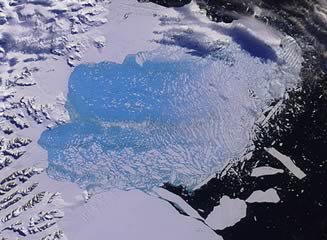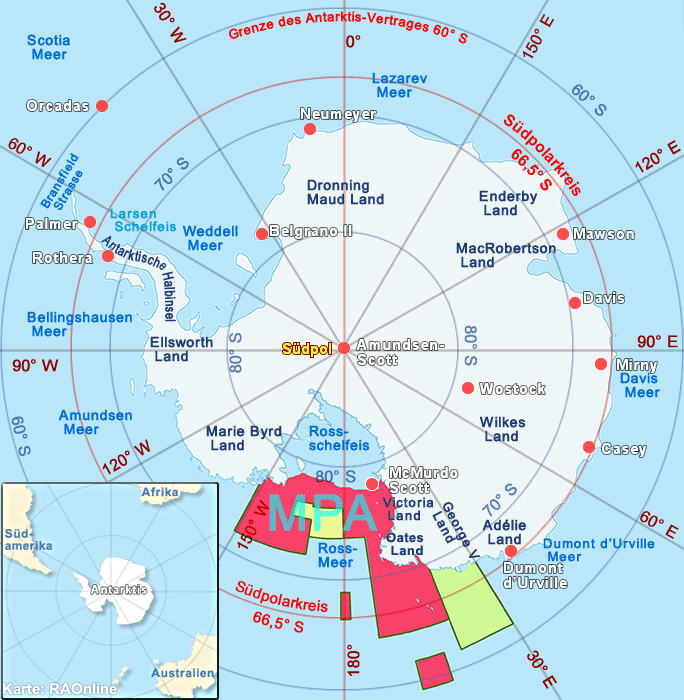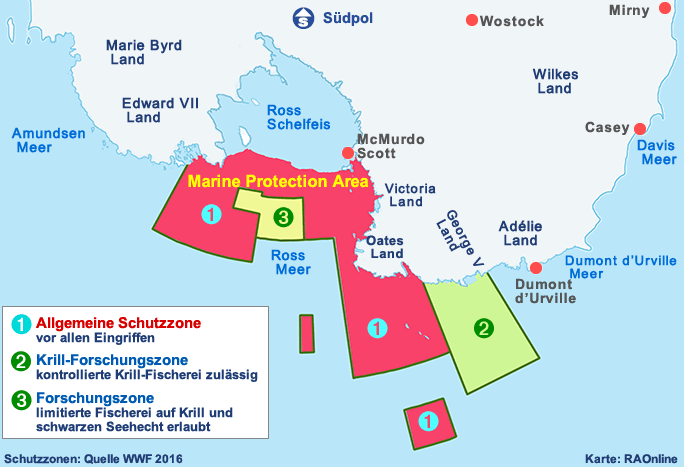 |
Antarktis Vertrag |
|
 |
Antarktis Informationen |
|
| CCAMLR-Mitgliedsstaaten vereinbaren Schutzzonen im Rossmeer |
 |
 |
| Der Antarktische Ozean erhält mehr Schutz. Die Mitgliedsstaaten der internationalen Kommission zur Erhaltung lebender Meeresressourcen (CCAMLR) einigten sich im Australischen Hobart darauf, eine riesige Fläche von 1'550'000 Quadratkilometern im Rossmeer besser zu schützen. Die ausgewiesene Zone im Rossmeer bildet die grösste geschützte Meeresfläche der Welt und ist so gross wie Frankreich, Deutschland und Spanien zusammen. WWF begrüsst die Ausweisung des Gebiets ausdrücklich, sieht jedoch die zeitliche Befristung der Vereinbarung auf eine Laufzeit von 35 Jahren kritisch. |
|
 |
 |
 |
 |
"Diese historischeEntscheidung markiert einen Wendepunkt für den Schutz der Antarktis und des Südpolarmeers und bringt uns dem permanenten Erhalt dieser letzten Wildnis näher. Die letzten unberührten Meere auf dem Planeten zu schützen, ist nicht nur für die dort heimischen Tierarten wie Pinguine, Robben oder Krill wichtig, sondern erhöht die Widerstandskraft des Ozeans gegen die Veränderungen des Klimawandels", sagt Stephan Lutter, Meeresschutzexperte des WWF Deutschland."Meeresschutz verträgt kein Verfallsdatum. Die eisigen Gewässer um die Antarktis sind Grundlage des dortigen Lebens. Und sie werden zukünftig Rückzugsraum für kälteliebende Arten werden, die Zeit brauchen, um sich an die Erwärmung der Meere anzupassen".
Nach den Regeln der Weltnaturschutzunion IUCN müssen Meeresschutzgebiete dauerhaft sein. Der WWF ist besorgt, dass die Vereinbarung zum Schutz des Rossmeeres diesen Standard nicht erfüllt und wird in den kommenden Jahren darauf hinarbeiten, dass das Gebiet dauerhaft unter Meeresschutz gestellt wird. "Befristete Regelungen sind Werkzeug des Fischereimanagements, nicht des Meeresschutzes, aber der einstimmig gefasste Beschluss hat eine jahrelange Blockade gelöst. Wir sind daher zuversichtlich, dass ein dauerhafter Schutz des Rossmeers, sowie weitere Schutzgebiete im Weddellmeer und der Ostantarktis in den kommenden Jahren möglich werden", so Lutter.
Das Südpolarmeer bedeckt etwa zehn Prozent der Weltmeeresfläche und gehört zu den produktivsten Meeren unseres Planeten. Das massenhafte Krill-Vorkommen ist Nahrungsgrundlage für verschiedene Robben- und Walarten wie Blau-, Finn- und Buckelwale sowie 120 Fischarten. Allein das Rossmeer beheimatet ein Drittel aller Adelie-Pinguine, ein Viertel aller Kaiserpinguine und die Hälfte aller südpazifischen Weddell-Robben. Die EU hat bei der diesjährigen CCAMLR-Tagung einen von Deutschland entwickelten Schutzgebietsvorschlag für das Weddellmeer vorgelegt. Um das vorgeschlagene Schutzgebiet in der Ostantarktis wird seit Jahren verhandelt.
Hintergrund:
Der CCAMLR- Beschluss weist für das Rossmeer folgende Schutzzonen aus:
1'117'000 km2 als Schutzzone vor allen Eingriffen
322'000km2 als Krill-Forschungszone, in der kontrollierter Krill-Fischerei zulässig ist
110'000 km2 als Forschungsgebiet, in dem limitierte Fischerei auf Krill und schwarzen Seehecht erlaubt ist
nach
oben
| CCAMLR to create world's largest Marine Protected Area |
 |
The world's experts on Antarctic marine conservation have agreed to establish a marine protected area (MPA) in Antarctica's Ross Sea.
This week at the Meeting of the Commission for the Conservation of Antarctic Marine Living Resources (CCAMLR) in Hobart, Australia, all Member countries have agreed to a joint USA/New Zealand proposal to establish a 1.55 million km2 area of the Ross Sea with special protection from human activities.
This new MPA, to come into force in December 2017, will limit, or entirely prohibit, certain activities in order to meet specific conservation, habitat protection, ecosystem monitoring and fisheries management objectives. Seventy-two percent of the MPA will be a 'no-take' zone, which forbids all fishing, while other sections will permit some harvesting of fish and krill for scientific research.
CCAMLR Executive Secretary, Andrew Wright, is excited by this achievement and acknowledges that the decision has been several years in the making.
"This has been an incredibly complex negotiation which has required a number of Member countries bringing their hopes and concerns to the table at six annual CCAMLR meetings as well as at intersessional workshops.
"A number of details regarding the MPA are yet to be finalised but the establishment of the protected zone is in no doubt and we are incredibly proud to have reached this point," said Mr Wright.
CCAMLR's Scientific Committee first endorsed the scientific basis for proposals for the Ross Sea region put forward by the USA and New Zealand in 2011. It invited the Commission to consider the proposals and provide guidance on how they could be progressed. Each year from 2012 to 2015 the proposal was refined in terms of the scientific data to support the proposal as well as the specific details such as exact location of the boundaries of the MPA. Details of implementation of the MPA will be negotiated through the development of a specific monitoring and assessment plan. The delegations of New Zealand and the USA will facilitate this process.
This year's decision to establish a Ross Sea MPA follows CCAMLR's establishment, in 2009, of the world’s first high-seas MPA, the South Orkney Islands southern shelf MPA, a region covering 94 000 km2 in the south Atlantic.
"This decision represents an almost unprecedented level of international cooperation regarding a large marine ecosystem comprising important benthic and pelagic habitats," said Mr Wright.
"It has been well worth the wait because there is now agreement among all Members that this is the right thing to do and they will all work towards the MPA's successful implementation," he said.
MPAs aim to provide protection to marine species, biodiversity, habitat, foraging and nursery areas, as well as to preserve historical and cultural sites. MPAs can assist in rebuilding fish stocks, supporting ecosystem processes, monitoring ecosystem change and sustaining biological diversity.
Areas closed to fishing, or in which fishing activities are restricted, can be used by scientists to compare with areas that are open to fishing. This enables scientists to research the relative impacts of fishing and other changes, such as those arising from climate change. This can help our understanding of the range of variables affecting the overall status and health of marine ecosystems.
What is CCAMLR?
The Commission for the Conservation of Antarctic Marine Living Resources
Established by an international treaty in 1982
Its objective is the conservation of Antarctic marine life while providing for rational use
25 Members and a further 11 countries have signed the Convention
The Secretariat (international Headquarters) is at 181 Macquarie Street, Hobart, Australia
Further information, including a five-minute video outlining the work of CCAMLR, is available via the About CCAMLR page.
nach
oben
| Weitere Informationen |
 |
|
Links
|
 |
 |
 |
Externe
Links |
|






